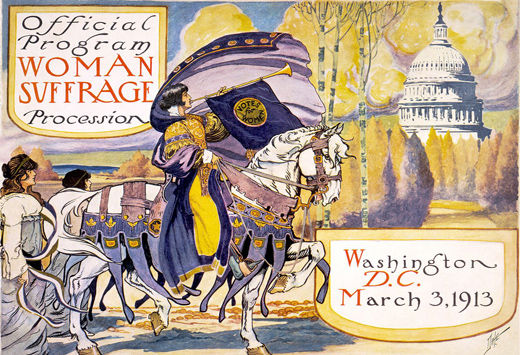
The Woman Suffrage Parade of 1913, officially the Woman Suffrage Procession, was the first suffragist demonstration in Washington, D.C. Organized by the suffragist Alice Paul for the National American Woman Suffrage Association (NAWSA), thousands of suffragists marched down Pennsylvania Avenue on March 3, 1913. The event was scheduled on the day before President Woodrow Wilson’s inauguration to “march in a spirit of protest against the present political organization of society, from which women are excluded,” as the official program stated.
Influenced by the militant tactics used by the British suffrage movement, American suffragists Alice Paul and Lucy Burns spearheaded a drive to adopt a national strategy for women’s suffrage in the National American Woman Suffrage Association. They recognized that women from the six states that had full suffrage at the time comprised a powerful voting bloc. After some disagreement and lobbying over the question whether or not to pursue a state-by-state strategy or aim for a change in federal law, these activists persuaded NAWSA to endorse an immense suffrage parade in Washington, D.C. that was to coincide with Wilson’s inauguration.
Affiliates of NAWSA from various states organized contingents to march and activities leading up to the march, such as suffrage hikes.
The parade itself was led by labor lawyer Inez Milholland, dressed dramatically in white and mounted on a white horse, and included 10 bands, five mounted brigades, 26 floats, and around 8,000 marchers, including many notables such as Helen Keller, who was scheduled to speak at Constitution Hall after the march. After a good beginning, the marchers encountered crowds, mostly male, on the street that should have been cleared for the parade. They were jeered and harassed while attempting to squeeze by the scoffing crowds, and the police were of little help, or even participated in the harassment.
The Massachusetts and Pennsylvania national guards stepped in. Eventually, students from the Maryland Agricultural College created a human barrier protecting the women from the angry crowd. Over 200 people were treated for injuries at local hospitals. Despite all this, most of the marchers finished the parade and viewed an allegorical tableau presented near the Treasury Building.
Racism rears its head
Indicative of the contradictions within the movement, African-American women were asked to march separately at the end of the march, because white suffragists were concerned about losing the support of Southern voters. There were delegations from the National Association of Colored Women and also from the capital city’s Howard University. Elsie Hill, the suffragist who recruited the Howard group, originally planned for them to march alongside other college groups; after news of this created controversy, Alice Paul placed a buffer of Quaker men around them to prevent protest from Southern suffragists. Despite all this, Ida B. Wells, founder of the Alpha Suffrage Club of Chicago, joined the Illinois delegation in the middle of the march.
The mistreatment of the marchers by the crowd and the police caused a great furor. Alice Paul shaped the public response after the parade, portraying the incident as symbolic of systemic government mistreatment of women, stemming from their lack of a voice and political influence through the vote. The incident showed that the government’s role in women’s lives had broken down, and that it was incapable of even providing women with physical safety. Journalist Nellie Bly, who had participated in the march, headlined her article “Suffragists are Men’s Superiors.”
Senate hearings, held by a subcommittee of the Committee on the District of Columbia, started on Mar. 6, only three days after the march, and lasted until Mar. 17, resulting in the replacement of the District’s superintendent of police. The march and the attention it attracted were important in advancing the vote for women in the United States. Passed by Congress June 4, 1919, and ratified on August 18, 1920, the 19th Amendment to the U.S. Constitution guarantees all American women the right to vote. At many times in our history, the margin of the women’s vote has swung elections in a more progressive direction.
Adapted from Wikipedia.
Photo: Wikipedia (CC)












Comments